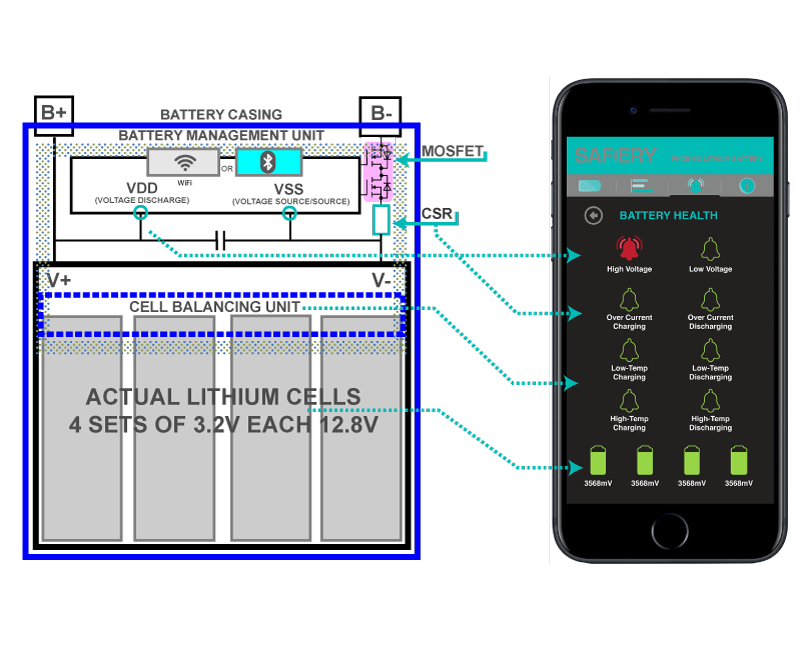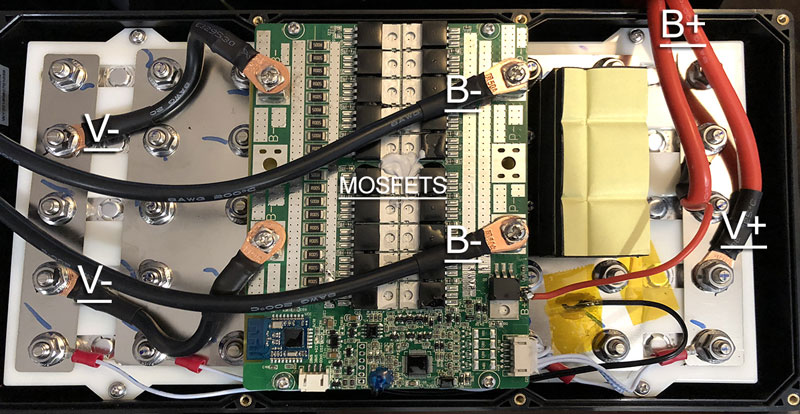
SAFIERY UNIVERSITY
LITHIUM BATTERIES
BATTERY VOLTAGE MAY NOT BE WHAT IS SEEMS…
This technical article is designed to give value to the reader through more knowledge on Lithium Batteries.

 Lithium Batteries consist of 4 sets of Lithium cells connected in series and make up the bulk of the Lithium Battery casing. The cells run in vertical layers longitudinally following the long side of the battery.
Lithium Batteries consist of 4 sets of Lithium cells connected in series and make up the bulk of the Lithium Battery casing. The cells run in vertical layers longitudinally following the long side of the battery.
Just below the top of the battery casing are the management units.
Right on top of the battery casing are the battery terminals… well, this is the part which is not quite correct and the purpose of this article.
The actual lithium battery cells have a nominal 3.2V each and are joined in series to give a total of 12.8V nominal. This can be measured at the inner battery terminals marked V+ and V-.
In normal operation, it is not possible to measure this voltage. The voltage that can be measured is at the battery terminals on top of the battery casing and is marked as B+ and B-.
The positive V+ and B+ are directly connected (fused only).
The negative V- and B- are not directly connected. The connection between these two passes through a Dual Mosfet Charge/ Discharge Controller and a Current Sense Ratio (CSR) device. The Dual Mosfet Controller is core to battery protection for over-charging current and high or low voltage cut-out. The protection unit will open and close the connection between B- and V- depending on the command of the Battery management Unit. There are several other sensor and measurement points involved.
When the protection unit opens this V- B- circuit, even though the lithium battery may be fully charged, battery terminals B+ and B- may show only 2-3 V or even nil on a multi-meter. (capacitors hold small voltage).
How could this occur you may ask?
It is not uncommon to see a lithium battery “over charged”. I have seen this with the more aggressive DC to DC chargers pumping in 14.6V at full power with a delay in turning off after the battery is full. The battery management unit will “turn off” the voltage to the terminals B+ and B- to protect the battery. Provided there hasn’t been a spike of power, the battery should not be damaged at all. Give it a good rest and it will come back to full voltage on the terminals B+ and B- after some natural decay.
However, with the battery going “dead’, some users will put the multi-meter accross the battery terminals B+ and B- and read near nil voltage. they may announce that the battery is stuffed! That would be an expensive and false call.
Throughout this overcharging, the actual cell voltage at V+ and V- are showing the real lithium battery voltage. How does the user read this?
Open up the Safiery lithium app as shown in the picture above. At the bottom of the app are 4 cells with voltages shown in mv. This is “milli-volt”. 1,000 mV to a volt. So the 3568mV is 3.568V. Add the four together and you arrive at the V+ and V- voltage. You will see the individual cell voltages fluctuating in mV between the cells. It is perfectly normal to see minor fluctuations.
You can now understand why it is difficult if not impossible to do an electronic test for capacity of a lithium battery. Ask the auto-electrician not to use their standard AGM battery tester please.
In a future blog, I’ll step through the proven way to test for battery capacity. However, the sum of the mV will give a good idea of the available voltage.
Here is a picture of the Battery Management Unit showing the multiple cables on the negative side going to the two rows of Mosfets. The cables are in pairs for capacity reasons. Each one is rated at 50A continuous to give a 100A continuous rating per battery. The avid electrical engineer reading this blog may enjoy a “where’s wally” for the CSR, Vdd and Vss points!

There is an article going around the traps that quotes a learned research paper on the challenges with cell balancing in Lithium Batteries. Be rest assured we comply with this article and the Cell Balancing Management does exactly what it is supposed to do. However, the author of the social media article either doesn’t understand the difference between cells and batteries or doesn’t have the right product to market.
Safiery Lithium Batteries are fitted with not just a Cell Balancing Management Unit but an additional Battery Management Unit which allows these batteries to be installed in parallel or series connection.
|
|
In Parallel Sets |
In Series Set |
In Series and Parallel |
|
Combined Voltage and Ahrs of Multiple 125 ahr Safiery lithium |
6 x 125 ahr Safiery lithium 12.8V 700Ahrs |
4 x 125 ahr Safiery lithium 51.2 V 125 Ahrs |
6 x 125 ahr Safiery lithium 25.6 V 375 Ahrs |
Battery Management Unit maps to Safiery App so the user can see the exact value of the Lithium cells.


